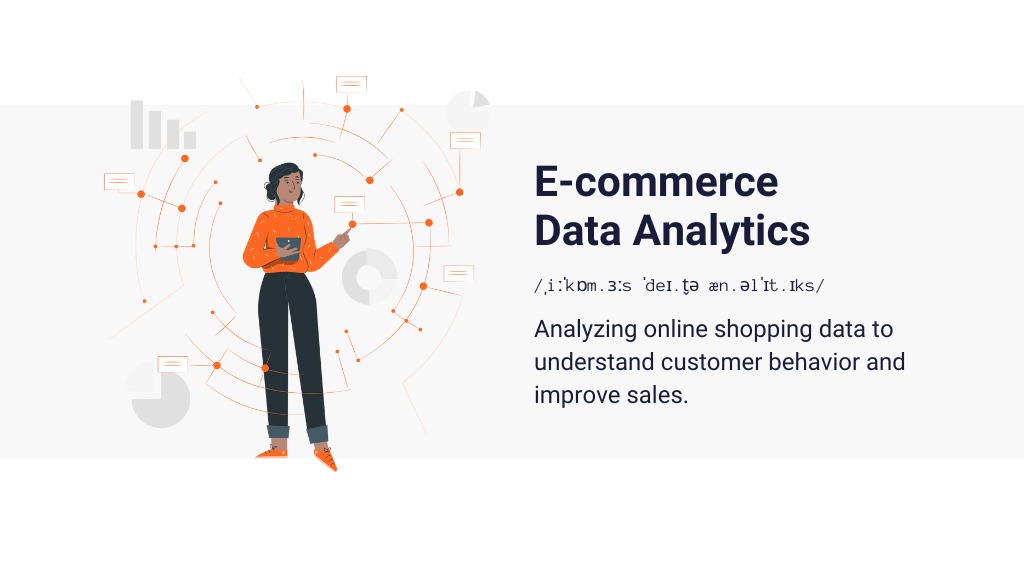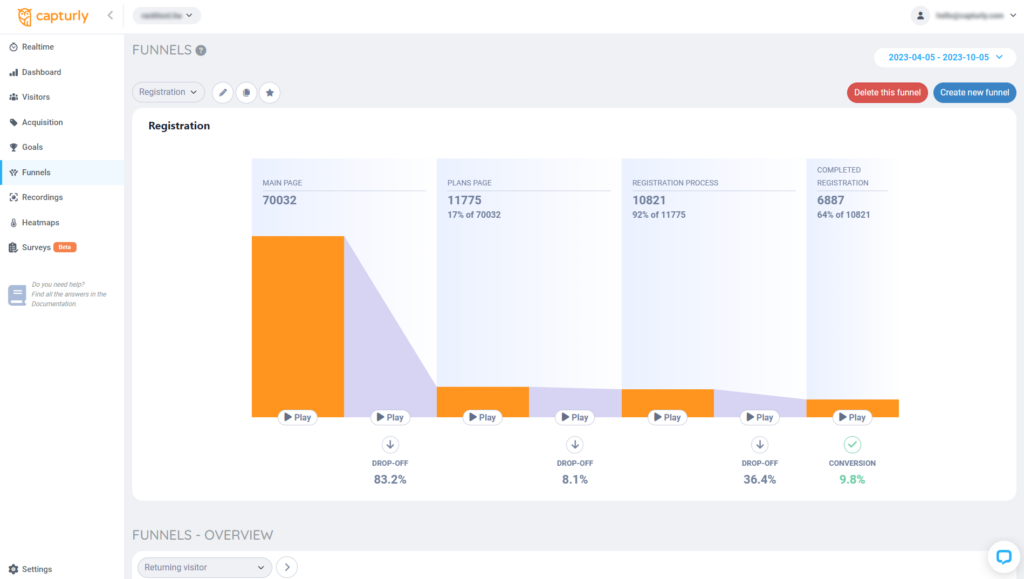Imagine a world where e-commerce takes over traditional brick-and-mortar stores. Sounds plausible? Well, it’s not just a vision anymore. Retail e-commerce sales are forecasted to skyrocket, aiming for a staggering 8.1 trillion dollars worldwide by 2026, according to Statista.
As this digital revolution continues, it’s no longer sufficient for e-commerce businesses to just “be online”. The real success lies in understanding and analyzing the vast amounts of data generated online.
That’s where e-commerce data analytics comes into play.
Navigating this extensive digital ocean can be overwhelming. However, with tools like Capturly, designed to understand online visitors’ behavior better, diving deep into the e-commerce analytics world becomes less daunting.
In this piece, I’ll share how you can leverage e-commerce data analytics, benefiting from Big Data to elevate your marketing and sales strategies.
But first, let’s define a few terms.
Table of Contents
Understanding E-Commerce Data Analytics
When we say “E-Commerce Data Analytics,” what are we really talking about? Let’s define it, alongside “Big Data.”
What is E-commerce Data Analytics?
E-commerce Data Analytics refers to the process of examining large sets of data to unearth hidden patterns, market trends, customer preferences, and other valuable insights specific to online retail environments.
In simpler terms, it’s the magnifying glass that reveals what’s working (and what’s not) in your e-commerce strategy.
But why is it gaining so much traction?
In our digital age, every click, view, and purchase generates data. When appropriately harnessed, this data can transform mere guesses into strategic decisions.
It’s the roadmap that guides e-commerce businesses toward better performance, customer satisfaction, and profitability. And it’s a huge step up from traditional analytics.

What is Big Data?
Big Data refers to the vast amount of structured and unstructured data that deluges businesses every day.
Nevertheless, the emphasis isn’t just on how much data there is, but on how companies put it to use. Savvy business owners can readily handle, analyze, and understand this data to make better choices.
Now you’re probably wondering why data analytics in e-commerce is a big deal and how you can leverage it in your business. I’ll discuss all of this in the next few sections.

Why Should You Embrace Data Analytics in E-Commerce?
The e-commerce world thrives on immediacy. Shoppers want instant results, recommendations, and gratification. This is where Big Data and data analytics play a huge role.
Below are reasons you should embrace data analytics in your e-Commerce business:
✅ Enhanced Customer Understanding
Imagine walking into a store where the salesperson knows not only your name but also your preferences, past purchases, and even what you might be looking for today.
This is the depth of understanding that data analytics offers e-commerce businesses. It’s like having a personal diary of each customer.

But, there’s even more:
- Analytics help businesses understand intricate patterns in customer behavior, from the frequency of their visits to their buying habits.
- E-commerce data analytics offers intricate details about who your customers are, their preferences, online behaviors, and more.
By examining data points like location, age, browsing habits, and purchase histories, businesses can tailor their marketing strategies to resonate more profoundly with their target demographic.
Consider this: Instead of a one-size-fits-all email campaign, what if you could send personalized recommendations based on a user’s browsing history?
Such granularity can not only enhance the user experience but can also help to improve your website’s conversion rate.
Here are e-commerce personalization opportunities:
- Show items based on users’ action
- Personalize the home page
- Personalize the search results
- Geo-location targeting
By segmenting customers based on behaviors or shared characteristics, e-commerce platforms can tailor shopping experiences, making every visitor feel seen and valued.
✅ Optimized Pricing Strategies
Pricing in e-commerce is akin to finding the perfect pitch in music. Too high, and you risk alienating your audience. Too low, and you undervalue your symphony.
Data analytics, in this analogy, is the tuning fork. It guides businesses in adjusting prices dynamically, considering ever-fluctuating factors like demand and competition. Plus, it aids in crafting enticing deals that not only lure customers but also ensure profitability.
✅ Personalization and Tailored Marketing
Every customer wishes to be treated as an individual, not just another face in the crowd. Through data analytics, e-commerce platforms can craft customized product recommendations, similar to having a personal shopper who knows exactly what you’d love.
Think about the delight of a customer who, after browsing winter jackets, receives a special discount offer for winter accessories. Such pinpointed marketing tactics, powered by data analytics, can exponentially boost customer engagement and sales.
The image below shows personalized product recommendations in action:

In addition to personalization, digital marketing campaigns become laser-focused. Instead of casting a wide net, businesses can aim their arrows precisely, ensuring that promotions resonate deeply with the targeted audience.
E-commerce data analytics also enables you to work smarter with chatbots. With insights from customer behavior data, identifying areas on your platform to integrate chatbots for an enhanced user experience becomes straightforward.
✅ Forecasting and Trend Analysis
Data analytics allows businesses to gaze into potential future trends, offering them a head-start in preparation.
For instance, if data reveals an emerging preference for sustainable products in the past six months, businesses can anticipate this trend’s growth and tailor their marketing strategies accordingly, highlighting eco-friendly products or sustainability initiatives.
Moreover, it also plays a pivotal role in risk management. By identifying potential market pitfalls, businesses can weave strategies to either avoid or counteract them, much like a chess player thinking five moves ahead.
✅ Improved Return on Investment (ROI)
Every business venture seeks a return, and e-commerce is no different. Imagine being on a treasure hunt but having a map that highlights where the bounty lies. Data analytics offers this map.
By understanding which strategies yield the best results, businesses can channel their efforts and funds effectively. It helps reveal which marketing channels are goldmines, ensuring that every penny spent is an investment, not an expense.
For example, say your data reveals that a specific social media platform has a higher conversion rate, you can allocate more budget to campaigns on that platform. Amid other eCommerce marketing tactics, you can get more brand ambassadors to create valuable and convincing user-generated content (UGC) on the platform.
6 Key Steps for Implementing E-Commerce Data Analytics Successfully
One secret to standing out and achieving long-term success in a bustling marketplace often lies in understanding and leveraging e-commerce data analytics.
But how does one begin this journey?
Here’s a step-by-step guide to illuminating your path with the power of data:

1️⃣ Choose the Right Analytical Tools
Different analytics tools serve varying purposes.
Do you need real-time insights or are you more focused on historical trends?
Some tools specialize in visitor behavior, while others are adept at sales forecasts. When picking your tool, ensure you gauge the following:
- Ease-of-use
- Scalability
- Integration capabilities
Platforms like Google Analytics offer a comprehensive overview of website activity, whereas others like Capturly allow for more event-based tracking.
Invest time in research and possibly trial runs to find the most suitable tools for your needs.
Capturly Website Analytics Tool
Start Your 14-day Free Trial Now >>>>
2️⃣ Gather and Consolidate Data
Data comes from diverse sources. Apart from data your analytics tool might pick up from your website activities, you can gather data from other sources also. For example:
- You can use an online form builder to create customized forms, embed them on your website, and then gather customer feedback directly on your site
- You can create social media polls, share them with your followers, and gather the results
- You can create email campaigns to gather specific feedback from your customers
Just remember that each touchpoint provides valuable information, and centralizing this data is critical.
3️⃣ Cleanse and Refine Data
Raw data can be messy. Before diving into analysis, ensure the data is clean and relevant. This involves eliminating outliers that might skew results, filling any data gaps, and removing redundancies.
Periodically auditing data ensures you’re working with a clean slate. After all, the insights are only as good as the data they’re derived from.
4️⃣ Delve into Deep Analysis
With clean, consolidated data at your fingertips, the real magic begins. Start with trend analysis to understand upward or downward shifts over time. Segmenting data can also offer granular insights. For instance, understanding the behavior of returning customers versus new ones.
Predictive analytics, while slightly advanced, can provide forecasts based on historical data, aiding in strategic decision-making.
Pro tip: Use Capturly’s conversion funnel tool to optimize your website.
5️⃣ Visualize and Share Insights
Numbers and spreadsheets might speak to a data scientist, but for the majority, visual representation offers clarity.
Platforms that allow for the creation of intuitive graphs, pie charts, or heat maps can transform complex data sets into easily digestible formats.
Sharing these visualizations with relevant teams, be it marketing, sales, or product development, ensures that the entire organization benefits from the insights.
6️⃣ Strategize, Execute, and Iterate
The final and perhaps most crucial step is turning insights into actionable strategies.
If data reveals a drop in website visits post-redesign, perhaps it’s time to revisit the changes and follow tested-and-trusted e-commerce web design best practices.
Did your data reveal a spike in sales during a particular marketing campaign? Maybe it’s worth extending or replicating it.
Once strategies are implemented, the cycle doesn’t end. Monitoring outcomes, gathering feedback, and continuously adapting ensures that your e-commerce business remains agile and ahead of the curve.

Capturly Conversion Funnel >>>
Challenges and Pitfalls to Avoid with E-Commerce Data Analytics
The expansive world of e-commerce data analytics offers valuable insights, but it’s also rife with potential pitfalls. Businesses looking to capitalize on the benefits of analytics should be aware of these challenges to prevent missteps.
Here’s a comprehensive look at some of the most common challenges and how to navigate around them.
❌ Overreliance on Vanity Metrics
Metrics like page views or social media followers might give a fleeting sense of success, but they don’t always translate to genuine customer engagement or conversions.
Instead of these superficial metrics, businesses should prioritize actionable ones, such as conversion rates or shopping cart abandonment rates. These indicators provide a deeper understanding of user behavior and the overall health of an e-commerce venture.
❌ Not Regularly Updating Data Sources
As e-commerce platforms evolve and customer behaviors shift, it’s imperative to refresh data sources. Real-time analytics tools, which capture live data, can be invaluable in ensuring your strategies align with the current digital landscape.
❌ Ignoring Mobile Analytics
Given the surge in mobile e-commerce, overlooking this platform is a missed opportunity.
Mobile users exhibit distinct behaviors, preferences, and pain points. E-commerce businesses should ensure their analytics tools capture mobile data accurately, allowing them to cater to this significant segment effectively.

❌ Data Silos
When different departments use separate tools for their specific needs, it can lead to a fragmented view of the business landscape.
While the marketing team might have insights into campaign performance, the sales team might hold data on conversion rates. Integrating these datasets can provide a more comprehensive overview, helping craft holistic strategies that consider every facet of the business.
❌ Relying Solely on Surface Metrics
While surface metrics such as clicks, page views, and bounce rates are essential, they merely scratch the surface of the broader business landscape.
To gain a deeper understanding, you need to dive into metrics that paint a comprehensive picture, like customer lifetime value or retention rates.
Think of it as managing a budget. While it’s useful to know daily expenditures, truly efficient financial management requires a deeper dive.
Just as you would manage business expenses to get a full view of your financial health, diving deeper into e-commerce metrics offers a richer understanding of your business performance.
❌ Over-analysis or Paralysis by Analysis
With the sheer volume of data available, there’s a temptation to dissect every bit of it. However, diving too deep without focus can lead to confusion and hinder timely decision-making. It’s essential to prioritize metrics that align with business goals and not get lost in a massive data pool.
❌ Misinterpreting Data
Data, without context, is open to multiple interpretations.
A sudden spike in website visits might seem like a positive trend, but without context, it could be due to a controversial ad or negative reviews going viral. Ensuring the analytics team is well-versed in the nuances of e-commerce and continually cross-referencing data can prevent such misinterpretations.

The Transformative Power of E-Commerce Data Analytics
E-commerce data analytics isn’t just a means to gather numbers. Beyond just numbers, it provides actionable insights to refine strategies, target audiences more precisely, and amplify sales.
As the e-commerce space booms, businesses that harness the power of data analytics will find themselves not only navigating with precision but also maximizing their sales and marketing outcomes.
Leverage data analytics today and position your e-commerce business for long-term success.
————————–
Author Bio
Reena is Director of Operations and Sales at Attrock, a result-driven digital marketing company. With 10+ years of sales and operations experience in the field of e-commerce and digital marketing, she is quite an industry expert. She is a people person and considers human resources as the most valuable asset of a company. In her free time, you would find her spending quality time with her brilliant, almost teenage daughter and watching her grow in this digital, fast-paced era.
Don't forget, sharing is caring! :)

